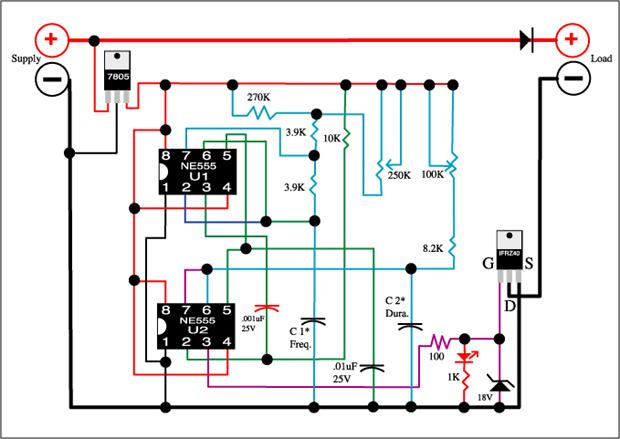Prabs & Ghurd,
The drawing is correct for the diode array. To use that 5th wire with bridges just add another bridge. The caps just smooth things out, unless I'm running my pulser circuit as seen below, at which point they become tiny little batteries. The caps main function, without the pulser circuit, is to smooth out the DC. Since these little motors don't have a voltage issue the final diode drop is not too worrisome for me. Yes each mill is treated individually, then the combined output fed to the bank. I don't think my 8 stepper mills would keep my 1320 AH 12V bank charged (14 6V 220AH golf carts). The wind would have to be in the +20 MPH range for some time. The blades are from dead 20" box fans. If I had 30 of these things it MIGHT keep up with the drain on my bank if I was in a really good wind zone, alas we get good wind only in the winter, aside from thunderstorms. I don't rely on these alone as we have 750+watts of solar and I have a Kubota diesel driving a large frame automotive alternator. I also have 2 GE ECM motors up and running as mills as well.
I think the resistance for each phase is 17 Ohms, on the TEAC motors. I have other makes so I can't say for sure as they're up and covered! I've replaced the bushings with sealed bearings on a couple of the "can" type steppers from inkjet printers that had much lower phase resistance. If it weren't such a hassel to replace the bushings I would replace all the drive steppers with that type.
My 8 steppers might be able to charge a single 12V battery given enough time and wind. I just see it like this. 12V X 5A=60watts. I have $2-$3 invested in each. That works out to about $.25 per watt, which is way cheap. I didn't pay for even the 5.25" drives, as they are throw away "junk" computer equipment. The caps and diodes/bridges are also salvaged items from other tossed electronics. The JB weld, solder and other bits are all I had to buy. Prabs, check out all the computer shops in your area to see what's out there. Ask schools for old equipment.
The schematic below is a good way to use the low amperage output of these or other steppers. The first NE555 acts as a multivibrator, setting the pulse frequency via C1 and the 250K variable resistor. The second NE555 acts as a one shot, setting the duration of the pulse via C2 and the 100K variable resistor. The LM7805 limits the voltage to the timers and protects them from the voltage swings common to wind power. The FET drives the negative side pulses into the battery bank. The 18V zenner diode protects the whole show by turning on the FET if the voltage goes too high between pulses, and dumping the capacitors on the mills power without the drive from the timers. With a good wind and this circuit running I have seen both elements of an 1157 bulb flash very brightly. One could build a very large capacitor bank right at the circuit, just ahead of the LM7805, and get some pretty stiff pulses by lengthening the fequency accordingly. No, one does not gain power using this, but rather let the steppers spool up free of the clamping action of being directly connected to the battery bank. This allows the voltage to build in the capacitors and then suddenly drain them. Whether this pulsng action helps battery desulphation or not is open to debate, but I like seeing the needle jump on my analog voltmeter when it fires. One could run this directly from the battery bank, eleminate the 18V zenner and LM7805, and adjust the frequency to make a crude desulphator.

Hope this helps,